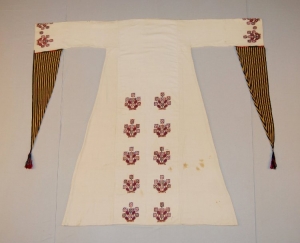The trousers are decorated with narrow bands of embroidery around the hems. These bands include several rows of geometric shapes, such as a central band of connecting diamonds, flanked by diagonal rectangles, and then triangles or rows of smaller diamonds. The bands are normally worked with various stitches, including cross stitch, trammed cross stitch, and double running stitch.
Over the trousers is worn a white dress (thob), which normally has straight sleeves for daily life versions, while long, triangular (winged) sleeves are associated with festivals and weddings. The triangular sleeve section on most of the festive Qalamoun garments is usually in a different material from the main body of the garment.
The embroidered decoration on Qalamoun dresses is concentrated on the front skirt section and the cuffs of the sleeves. In the nineteenth century the dress panels were heavily embroidered, but by the mid-twentieth century the embroidery had become significantly less. The main embroidered section is a panel down the front of the skirt section.
In some cases the main design is a large niche shape, which dominated the lower front of the garment. This panel may be totally filled with embroidery, or the pattern may consist of rows of isolated dots or stars. Other Qalamoun dresses have a main skirt decoration consisting of two narrow bands topped by triangles. The latter are sometimes described as minarets. The sleeve hems are usually also decorated. The back of theses dresses generally have a series of isolated motifs along the lower edge of the garments.
During the late nineteenth and much of the twentieth centuries, Qalamoun women wore waistcoats with decorative panels. In general, the older examples tend to be decorated with metal thread couching, while more recent ones have cross stitch patterns. By the end of the twentieth century, Qalamoun style embroidery was being produced on a new range of materials and garments, which appealed to a younger market.
See also the TRC Needles entry on Quteife embroidered dresses
Sources:
- KAWAR, Widad, Layla PIO and Gillian VOGELSANG-EASTWOOD (2016). 'Syrian embroidery,' in: Gillian Vogelsang-Eastwood (ed.), Encyclopedia of Embroidery from the Arab World, London: Bloomsbury Academic, pp. 444-475.
- ZERRNICKEL, Maria (1992). ‘Textile techniques,' in: Kalter, Joannes, Margareta Pavaloi and Maria Zerrnickel, The Arts and Crafts of Syria, London: Thames and Hudson, p. 182.
British Museum online catalogue (retrieved 3 June 2016).
GVE
